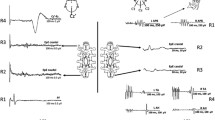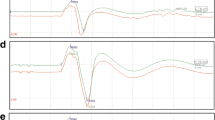Summary
Changes in vestibulospinal evoked potentials (VsEP) and motor evoked potentials (MEP) were examined in 10 cats before and after two different weight-dropping spinal cord injuries. In six animals somatosensory evoked potentials (SEP) were also monitored. The recordings were done from epidural spinal cord electrodes. Before and after severe and light weight-dropping spinal cord injuries all 3 modalities were recorded at the same time intervals till the end of 4th hour postinjury. According to a scoring system, evoked potential changes below and above the level of injury were monitored, and compared with each other.
This study showed that the different motor stimulation methods use different descending spinal tracts, and both can be ueful as a monitoring tool. Both descending tracts carrying VsEP and MEP had similarly remarkable changes after severe spinal cord injury. These consisted of major deformation, development of an evoked injury potential and complete potential loss. During the 4 hour monitoring period, no case showed EP recovery in the severe injury group. Light spinal cord injury caused somewhat more deterioration in MEPs than VsEP.
The higher numbers of severe potential alterations in the lightly injured animals suggest that MEP is a more sensitive method for spinal cord monitoring compared to VsEP and also to SEP. On the other hand, this sensitivity might be a disadvantage during intraoperative monitoring, if MEP alone were used.
Similar content being viewed by others
References
Andersson S, Gernandt BE (1956) Ventral root discharge in response to vestibular and proprioceptive stimulation. J Neurophysiol 19: 524–543
Baskin DS, Simpson RK (1987) Corticomotor and somatosensory evoked potential evaluation of acute spinal cord injury in the rat. Neurosurgery 20: 871–877
Boyd SG, Rothwell JC, Cowan JMA, Webb PJ, Morley T, Asselman P, Marsden CD (1986) A method of monitoring function in corticospinal pathways during scoliosis surgery with a note on motor conduction velocities. J Neurol Neurosurg Psychiatry 49: 251–257
Cheng MK, Robertson C, Grossman RG, Foltz R, Williams W (1984) Neurological outcome correlated with spinal evoked potentials in a spinal cord ischemia model. J Neurosurg 60: 786–795
Deecke L, Tator CH (1973) Neurophysiological assessment of afferent and efferent conduction in the injured spinal cord of monkeys. J Neurosurg 39: 65–74
Ducker TB, Hamit HF (1976) Experimental injury of the spinal cord. In: Vinken PJ, Bruyn GW (eds) Handbook of clinical neurology, Vol.25. North Holland Publ Co, Amsterdam, pp 9–26
Elidan J, Langhofer L, Honrubia V (1987) Recording of shortlatency vestibular evoked potentials induced by acceleration impulses in experimental animals: current status of the method and its applications. EEG Clin Neurophysiol 68: 58–69
Fehlings MG, Tator CH, Linden RD, Piper IR (1988) Motor and somatosensory evoked potentials recorded from the rat. EEG Clin Neurophysiol 69: 65–78
Fehlings MG, Tator CH, Linden RD, Piper IA (1987) Motor evoked potentials recorded from normal and spinal cord-injured rats. Neurosurgery 20: 125–130
Gacek RR (1969) The course and central termination of first order neurons supplying vestibular endorgans in the cat. Acta Otolaryngol [Suppl] (Stockh) 254: 1–66
Gernandt BE, Igarashi B, Ades HW (1966) Effects of prolonged caloric stimulation upon oculomotor, vestibulospinal and segmental spinal activity. Exp Neurol 14: 249–263
Gernandt BE, Iranyi M, Livingston RB (1959) Vestibular influences on spinal mechanisms. Exp Neurol 1: 248–273
Gernandt BE, Gilman S (1959) Descending vestibular activity and its modulation by proprioceptive cerebellar and reticular influences. Exp Neurol 1: 274–304
Gernandt BE (1974) Vestibulo-spinal mechanisms. In: Konhuber HH (ed) Handbook of sensory physiology, vestibular system, Vol 6. Springer, Berlin Heidelberg New York, pp 541–564
Ginsburg HH, Shetter AG, Raudzens PA (1985) Postoperative paraplegia with preserved intraoperative somatosensory evoked potentials—case report. J Neurosurg 63: 296–300
Gruder JA, Young W, DeCrescito V (1984) The vestibulospinal free fall response: a test of descending function in spinal-injured cats. CNS Trauma 1: 139–159
Katayama Y, Tsubokowa T, Sugitani M, Maejima S, Hirayama T, Yamamoto T (1986) Assessment of spinal cord injury with multimodality evoked spinal cord potentials. Part 1. localization of lesions in experimental spinal cord injury. Neuro-Orthopedics 1: 130–141
Katayama Y, Tsubokawa T, Yamamoto T, Hirayama T, Maejima S (1988) Preoperative determination of the level of spinal cord lesions from the killed end potential. Surg Neurol 29: 91–94
Levy WJ (1983) Spinal evoked potentials from the motor tracts. J Neurosurg 58: 38–44
Levy WJ (1987) Clinical experience with motor and cerebellar evoked potential monitoring. Neurosurgery 20: 169–182
Levy WJ, McCaffrey M, Hagichi S (1987) Motor evoked potential as a predictor of recovery in chronic spinal cord injury. Neurosurgery 20: 138–142
Levy WJ, McCaffrey M, York D (1986) Motor evoked potentials in cats with acute spinal cord injury. Neurosurgery 19: 9–19
Levy WJ, York DH, McCaffrey M, Tanzer F (1984) Motor evoked potentials from transcranial stimulation of the motor cortex in cats. Neurosurgery 15: 214–227
Nacimiento AC, Bartels M, Loew F (1986) Acute changes in somatosensory evoked potentials following graded experimental spinal cord compression. Surg Neurol 25: 62–66
Osterholm JL (1974) The pathophysiological response to spinal cord injury-current status of related research. J Neurosurg 40: 5–33
Patil AA, Nagaraj MP, Mehta R (1985) Cortically evoked motor action potential in spinal cord injury research. Neurosurgery 16: 473–476
Schramm J, Shigeno T, Brock M (1983) Clinical signs and evoked response alterations associated with chronic experimental cord compression. J Neurosurg 58: 734–741
Schramm J, Krause R, Shigeno T, Brock M (1983) Experimental investigation on the spinal cord evoked injury potential. J Neurosurg 59: 485–492
Schramm J (1985) Spinal cord monitoring: current status and new developments. CNS Trauma 2–3: 207–227
Shimoji K, Maruyama Y, Shimizu H, Fujioka H, Taga K (1985) Spinal cord monitoring—a review of current techniques and knowledge. In: Schramm J, Jones JS (eds) Spinal cord monitoring. Springer, Berlin Heidelberg New York, pp 16–28
Simpson RK, Baskin DS (1987) Corticomoter evoked potentials in acute and chronic blunt spinal cord injury in the rat: correlation with neurological outcome and histological damage. Neurosurgery 20: 131–137
Tsubokowa T, Katayama Y, Maejima S, Hirayama T, Yamamoto T (1987) Assessment of spinal cord injury with multimodality evoked spinal cord potentials. Part 2. correlation with neurological outdome in clinical spinal cord injury. Neuro-Orthopedics 3: 82–89
York DH, Watts C, Raffensperger M, Spagnolia T (1984) Somatosensory evoked potentials and caloric-induced potentiation of H-reflexes: prognostic implications for spinal cord injury. In: Nodar RH, Barber C (eds) Evoked potentials II. Butterworths, Boston, pp 392–397
York DH (1987) Review of descending motor pathways involved with transcranial stimulation. Neurosurgery 20: 70–73
Young W, Tomasula JJ, DeCrescito V, Flamm E, Ransohoff J (1980) Vestibulospinal monitoring in experimental spinal trauma. J Neurosurg 52: 64–72
Author information
Authors and Affiliations
Rights and permissions
About this article
Cite this article
Zileli, M., Taniguchi, M., Cedzich, C. et al. Vestibulospinal evoked potential versus motor evoked potential monitoring in experimental spinal cord injuries of cats. Acta neurochir 101, 141–148 (1989). https://doi.org/10.1007/BF01410530
Issue Date:
DOI: https://doi.org/10.1007/BF01410530




